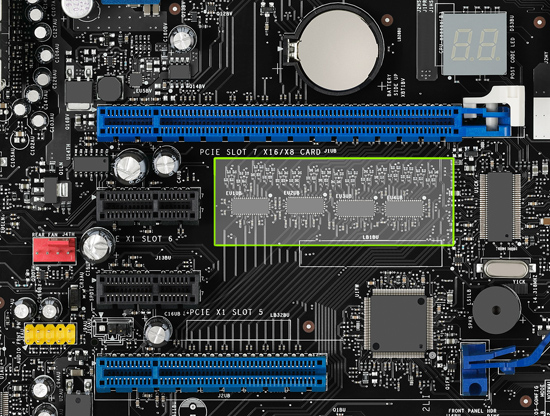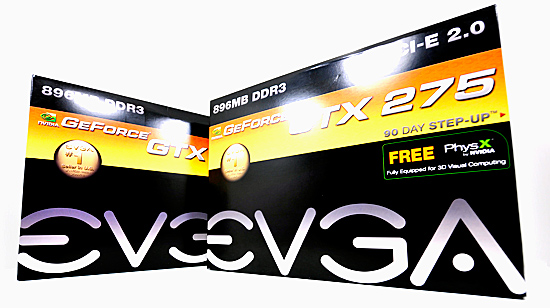Intel's Core i7 870 & i5 750, Lynnfield: Harder, Better, Faster Stronger
by Anand Lal Shimpi on September 8, 2009 12:00 AM EST- Posted in
- CPUs
Multi-GPU SLI/CF Scaling: Lynnfield's Blemish
When running in single-GPU mode, the on-die PCIe controller maintains a full x16 connection to your graphics card:

Hooray.
In multi-GPU mode, the 16 lanes have to be split in two:

To support this the motherboard maker needs to put down ~$3 worth of PCIe switches:

Now SLI and Crossfire can work, although the motherboard maker also needs to pay NVIDIA a few dollars to legally make SLI work.
The question is do you give up any performance when going with Lynnfield's 2 x8 implementation vs. Bloomfield/X58's 2 x16 PCIe configuration? In short, at the high end, yes.
I looked at scaling in two games that scaled the best with multiple GPUs: Crysis Warhead and FarCry 2. I ran all settings at their max, resolution at 2560 x 1600 but with no AA.
I included two multi-GPU configurations. A pair of GeForce GTX 275s from EVGA for NVIDIA:

A coupla GPUs and a few cores can go a long way
And to really stress things, I looked at two Radeon HD 4870 X2s from Sapphire. Note that each card has two GPUs so this is actually a 4-GPU configuration, enough to really stress a PCIe x8 interface.
First, the dual-GPU results from NVIDIA.
| NVIDIA GeForce GTX 275 | Crysis Warhead (ambush) | Crysis Warhead (avalanche) | Crysis Warhead (frost) | FarCry 2 Playback Demo Action |
| Intel Core i7 975 (X58) - 1GPU | 20.8 fps | 23.0 fps | 21.4 fps | 41.0 fps |
| Intel Core i7 870 (P55) 1GPU | 20.8 fps | 22.9 fps | 21.5 fps | 40.5 fps |
| Intel Core i7 975 (X58) - 2GPUs | 38.4 fps | 42.3 fps | 38.0 fps | 73.2 fps |
| Intel Core i7 870 (P55) 2GPUs | 38.0 fps | 41.9 fps | 37.4 fps | 65.9 fps |
The important data is in the next table. What you're looking at here is the % speedup from one to two GPUs on X58 vs. P55. In theory, X58 should have higher percentages because each GPU gets 16 PCIe lanes while Lynnfield only provides 8 per GPU.
| GTX 275 -> GTX 275 SLI Scaling | Crysis Warhead (ambush) | Crysis Warhead (avalanche) | Crysis Warhead (frost) | FarCry 2 Playback Demo Action |
| Intel Core i7 975 (X58) | 84.6% | 83.9% | 77.6% | 78.5% |
| Intel Core i7 870 (P55) | 82.7% | 83.0% | 74.0% | 62.7% |
For the most part, the X58 platform was only a couple of percent better in scaling. That changes with the Far Cry 2 results where X58 manages to get 78% scaling while P55 only delivers 62%. It's clearly not the most common case, but it can happen. If you're going to be building a high-end dual-GPU setup, X58 is probably worth it.
Next, the quad-GPU results from AMD:
| AMD Radeon HD 4870 X2 | Crysis Warhead (ambush) | Crysis Warhead (avalanche) | Crysis Warhead (frost) | FarCry 2 Playback Demo Action |
| Intel Core i7 975 (X58) - 2GPUs | 25.8 fps | 31.3 fps | 27.0 fps | 70.9 fps |
| Intel Core i7 870 (P55) 2GPUs | 24.4 fps | 31.1 fps | 26.6 fps | 71.4 fps |
| Intel Core i7 975 (X58) - 4GPUs | 27.0 fps | 57.4 fps | 47.9 fps | 117.9 fps |
| Intel Core i7 870 (P55) 4GPUs | 24.2 fps | 50.0 fps | 36.5 fps | 116 fps |
Again, what we really care about is the scaling. Note how single GPU performance is identical between Bloomfield/Lynnfield, but multi-GPU performance is noticeably lower on Lynnfield. This isn't going to be good:
| 4870 X2 -> 4870 X2 CF Scaling | Crysis Warhead (ambush) | Crysis Warhead (avalanche) | Crysis Warhead (frost) | FarCry 2 Playback Demo Action |
| Intel Core i7 975 (X58) | 4.7% | 83.4% | 77.4% | 66.3% |
| Intel Core i7 870 (P55) | -1.0% | 60.8% | 37.2% | 62.5% |
Ouch. Maybe Lynnfield is human after all. Almost across the board the quad-GPU results significantly favor X58. It makes sense given how data hungry these GPUs are. Again, the conclusion here is that for a high end multi-GPU setup you'll want to go with X58/Bloomfield.
A Quick Look at GPU Limited Gaming
With all of our CPU reviews we try to strike a balance between CPU and GPU limited game tests in order to show which CPU is truly faster at running game code. In fact all of our CPU tests are designed to figure out which CPUs are best at a number of tasks.
However, the vast majority of games today will be limited by whatever graphics card you have in your system. The performance differences we talked about a earlier will all but disappear in these scenarios. Allow me to present data from Crysis Warhead running at 2560 x 1600 with maximum quality settings:
| NVIDIA GeForce GTX 275 | Crysis Warhead (ambush) | Crysis Warhead (avalanche) | Crysis Warhead (frost) |
| Intel Core i7 975 | 20.8 fps | 23.0 fps | 21.4 fps |
| Intel Core i7 870 | 20.8 fps | 22.9 fps | 21.5 fps |
| AMD Phenom II X4 965 BE | 20.9 fps | 23.0 fps | 21.5 fps |
They're all the same. This shouldn't come as a surprise to anyone, it's always been the case. Any CPU near the high end, when faced with the same GPU bottleneck, will perform the same in game.
Now that doesn't mean you should ignore performance data and buy a slower CPU. You always want to purchase the best performing CPU you can at any given pricepoint. It'll ensure that regardless of the CPU/GPU balance in applications and games that you're always left with the best performance possible.
The Test
| Motherboard: | Intel DP55KG (Intel P55) Intel DX58SO (Intel X58) Intel DX48BT2 (Intel X48) Gigabyte GA-MA790FXT-UD5P (790FX) |
| Chipset: | Intel X48 Intel X58 Intel P55 AMD 790FX |
| Chipset Drivers: | Intel 9.1.1.1015 (Intel) AMD Catalyst 9.8 |
| Hard Disk: | Intel X25-M SSD (80GB) |
| Memory: | Qimonda DDR3-1066 4 x 1GB (7-7-7-20) Corsair DDR3-1333 4 x 1GB (7-7-7-20) Patriot Viper DDR3-1333 2 x 2GB (7-7-7-20) |
| Video Card: | eVGA GeForce GTX 280 |
| Video Drivers: | NVIDIA ForceWare 190.62 (Win764) NVIDIA ForceWare 180.43 (Vista64) NVIDIA ForceWare 178.24 (Vista32) |
| Desktop Resolution: | 1920 x 1200 |
| OS: | Windows Vista Ultimate 32-bit (for SYSMark) Windows Vista Ultimate 64-bit Windows 7 64-bit |
Turbo mode is enabled for the P55 and X58 platforms.










343 Comments
View All Comments
strikeback03 - Tuesday, September 8, 2009 - link
How would you have graphics then? You would be limited to the 4xPCIe off the P55 on motherboards which support it, as there are no integrated graphics (yet)MX5RX7 - Tuesday, September 8, 2009 - link
I'm not sure that CPU/GPU integration is a good thing, from a consumer standpoint. At least in the short term.For example, in the article you mention how the majority of modern games are GPU, not CPU limited. The current model allows us to purchase a very capable processor and pair it with a very capable GPU. Then, when the ultra competitive GPU market has provided us with a choice of parts that easily eclipse the performance of the previous generation, we either swap graphics cards for the newer model, or purchase a second now cheaper identical card and (hopefully) double our game performance with SLI or Crossfire. All without having to upgrade the rest of the platform.
With the current model, a new graphics API requires a new graphics card. With Larrabee, it might very well require a whole new platform.
Ben90 - Tuesday, September 8, 2009 - link
Yea, im really excited for Larrabee, who knows if it will be good or not... but with intel kicking ass in everything else, it will at least be interestingWith overclocking performance seemingly being limited by the PCI-E controller, it seems like an unlocked 1156 would be pretty sweet
All in all i gotta admit i was kinda bitter with this whole 1156 thing because i jumped on the 1336 bandwagon and it seemed that Intel was mostly just jacking off with the new socket... but this processor seems to bring a lot more innovation than i expected (just not in raw performance, still great performance though)
chizow - Tuesday, September 8, 2009 - link
Was worried no one was going to properly address one of the main differences between P55 and X58, thanks for giving it a dedicated comparison. Although I would've like to have seen more games tested, it clearly indicates PCIE bandwidth becoming an issue with current generation GPUs. This will only get worst with the impending launch of RV8x0 and GT300.Anand Lal Shimpi - Tuesday, September 8, 2009 - link
PCIe bandwidth on Lynnfield is only an issue with two GPUs, with one you get the same 16 lanes as you would on X58 or AMD 790FX.If I had more time I would've done more games, I just wanted to focus on those that I knew scaled the best to see what the worst case scenario would be for Lynnfield.
In the end 2 GPUs are passable (although not always ideal on Lynnfield), but 4 GPUs are out of the question.
Take care,
Anand
JumpingJack - Thursday, September 10, 2009 - link
Anand, a few other sites have attempted SLI/Xfire work ... on in particular shows 4 GPUs having no impact at all on gaming performance in general -- well, 3 or 4 FPS, but nothing more than a few percentages over norm.Could your configuration with beta or just bad first release drivers be an issue?
Jack
JonnyDough - Tuesday, September 8, 2009 - link
Would it be possible to incorporate two GPU controllers onto a die instead of one or is that what they'll be doing with future procs? I would think that two controllers with a communication hub might supply the needed bandwidth of x16 + x16.Comdrpopnfresh - Tuesday, September 8, 2009 - link
with two gpu's being passable- do you foresee that applying to both two independent gpus, as well as the single dual-card gpus?Ryan Smith - Tuesday, September 8, 2009 - link
Yes. The only difference between the two is where the PCIe bridge chip is. In the former it's on the mobo, in the latter it's on the card itself.Eeqmcsq - Tuesday, September 8, 2009 - link
Talk about bringing a bazooka to a knife fight. AMD better be throwing all their innovation ideas and the kitchen sink into Bulldozer, because Intel is thoroughly out-innovating AMD right now.